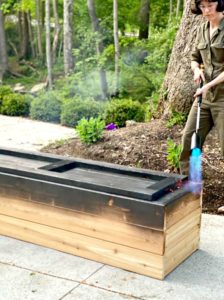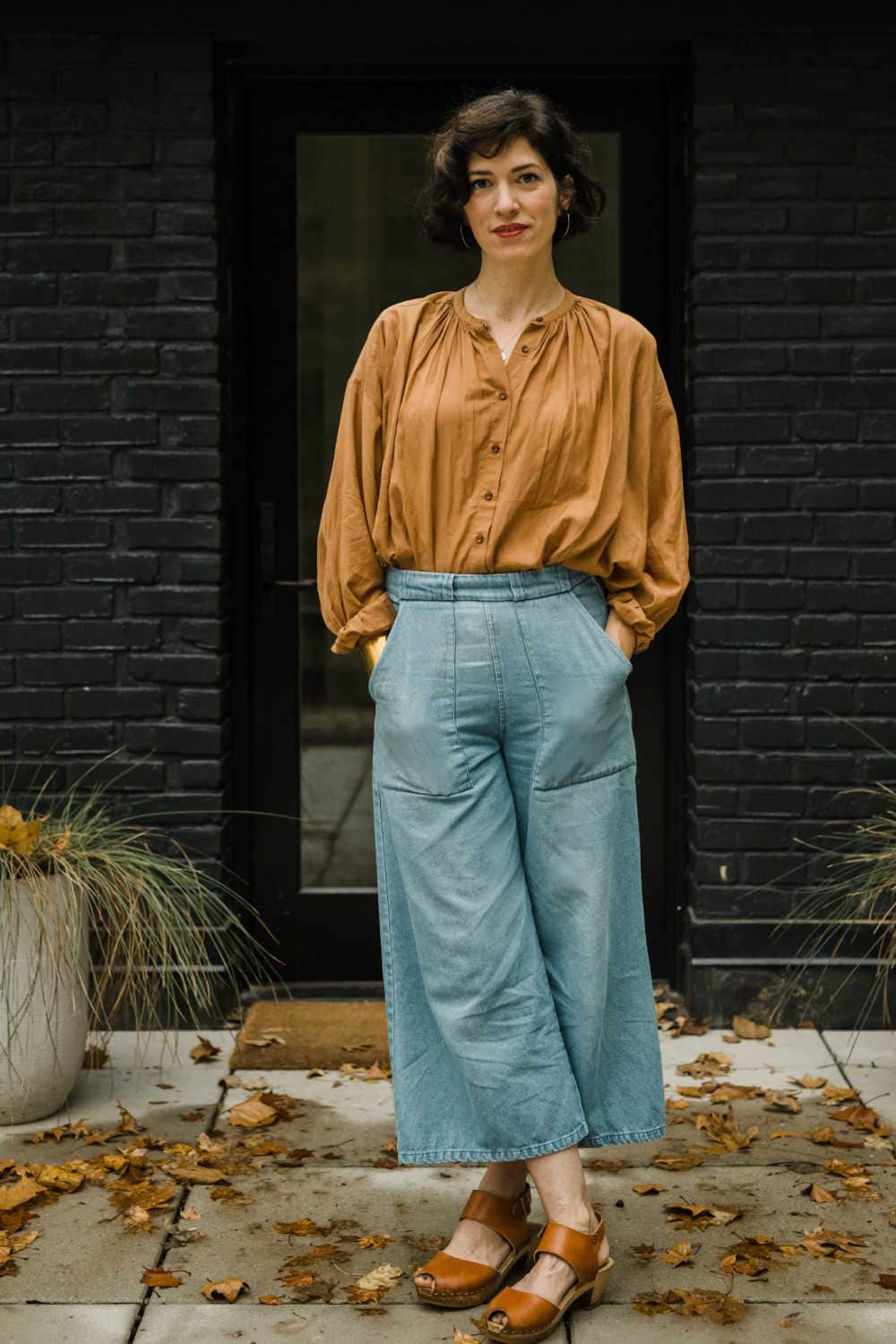.jpg) It seemed almost too late in the season to hope for a garden, especially since I wasn’t even sure where I wanted to put planter beds. We live on a wooded lot and our yard gets a lot of shade during the day. Additionally, I didn’t want them to look too random, like we just put some garden beds in the middle of our yard–I wanted them to be part of a cohesive plan for the entire yard, something I had not mapped out yet. Then, in doing some research I stumbled upon the idea of a patio or porch garden. Ding, ding, ding! This was the perfect solution for our re-entry into the world of gardening.
It seemed almost too late in the season to hope for a garden, especially since I wasn’t even sure where I wanted to put planter beds. We live on a wooded lot and our yard gets a lot of shade during the day. Additionally, I didn’t want them to look too random, like we just put some garden beds in the middle of our yard–I wanted them to be part of a cohesive plan for the entire yard, something I had not mapped out yet. Then, in doing some research I stumbled upon the idea of a patio or porch garden. Ding, ding, ding! This was the perfect solution for our re-entry into the world of gardening.
We decided on 3 large planters for our patio that we would make out of cedar–a naturally rot resistant wood. But I also knew that I wanted the planter boxes to be black. Enter shou sugi ban–the Japanese technique of preserving wood through burning it..jpg) I honestly can’t remember if it was my husband or I who came up with the idea to do shou sugi ban, as both of us were familiar with the technique, but we were both immediately on board! And as we showed the process in my Instagram stories you guys went NUTS for it! Rightfully so, it’s pretty fun to watch people burning things with a larger torch, and the planters turned out great! Honestly, better than I expected. It was one of the more enjoyable projects to date. This past weekend, we also shou sugi ban’d our bridge fence, which we had initially planned on painting black, but this process is so much easier AND durable.
I honestly can’t remember if it was my husband or I who came up with the idea to do shou sugi ban, as both of us were familiar with the technique, but we were both immediately on board! And as we showed the process in my Instagram stories you guys went NUTS for it! Rightfully so, it’s pretty fun to watch people burning things with a larger torch, and the planters turned out great! Honestly, better than I expected. It was one of the more enjoyable projects to date. This past weekend, we also shou sugi ban’d our bridge fence, which we had initially planned on painting black, but this process is so much easier AND durable.
Many people were asking questions and asking me to save the stories to a highlight. Additionally, several of you asked for more detailed instructions and even plans for the planters. This post is going to do both today! My husband spent some time drawing up detailed plans to scale for the 6 foot planter boxes–so nice–so you can make your own planter boxes and then burn them using a la shou sugi ban. To be clear, I will not be walking you through the process of building planter boxes, I am just posting the plans. Let’s get started!
But first, the disclaimers:
1. Please do not let this one blog post be the entirety of your research. I am so excited to share the process so as to hopefully demystify it for you and even show you how relatively simple it is, but we are beginners who have done this process exactly 2 times. I will share all our best tips and tricks, but please do additional research (time, money, process, safety) in addition to reading this post.
2. For the love, be safe. While using a giant torch actually became old-hat pretty quickly, you are still using a giant torch, with flames, attached to a gas outlet. Be aware of your children and animals at all times. Keep a hose nearby and ready to use at a moments notice. Don’t do this project in a dry field, next to a paper factory housed in a cardboard building. Dispose of your oily rags safely. The safety precautions are all on you sis!
Shou sugi ban supplies:
Garden Torch (This is the one my husband bought)
Propane tank
Boiled Linseed Oil (+ crappy brushes to brush it on with)
Wire or other brush of some sort (we didn’t use a wire brush–just one we had on hand)
Rags


We started by placing our planters in the center of our concrete driveway. We didn’t want to leave any burn marks on the ground so we would only burn the top half the the planter and then turn it over and do the other half, starting with the bottom first. (Yes you do want to burn all parts of the wood, even if you’re not going to see it because you want the tension to be even on all sides. Shou sugi ban is a finish, and if only one side of a board is finished, it creates an un-equal tension with the other side.) You just turn on the torch and start burning. Give yourself some time to get adjusted to the process–do you need more gas output, do you hold your torch close or far away, how long do you hold it in one place?

.jpg) I’ll tell you what we did: My husband usually turned up the gas pretty high (You control the output on the handle of the torch). It goes so much faster if you give yourself enough gas. You don’t want to hold it too close or too far away, my husband said about where the blue part of the torch fire ends. Lastly, you do have to go slower than I would have thought… it seems like surely it will just catch on fire, but it (usually) doesn’t (I will tell you when it does.) It’s like making creme brulee or baked Alaska–the torch is so hot it’s enough to sear the outside, but it’s not on there long enough to actually heat the inside. Also, when going over knots in the wood, you have to hold it in place even longer. A lot of times, after we thought we had finished a side, we’d see the knots were still quite light and we’d go back over them again.
I’ll tell you what we did: My husband usually turned up the gas pretty high (You control the output on the handle of the torch). It goes so much faster if you give yourself enough gas. You don’t want to hold it too close or too far away, my husband said about where the blue part of the torch fire ends. Lastly, you do have to go slower than I would have thought… it seems like surely it will just catch on fire, but it (usually) doesn’t (I will tell you when it does.) It’s like making creme brulee or baked Alaska–the torch is so hot it’s enough to sear the outside, but it’s not on there long enough to actually heat the inside. Also, when going over knots in the wood, you have to hold it in place even longer. A lot of times, after we thought we had finished a side, we’d see the knots were still quite light and we’d go back over them again.
The only time we found that the wood does catch on fire (in a completely controllable way) is when you’re torching the inside of the box (see photo above), and/or any little overhangs where the fire can sort of catch in a corner. Even in between the boards, in the corners and under the overhang of the main box by the base (basically any little nooks and crannies that the heat can get trapped) is where you can see the wood smoldering a little longer. You just go slower and actually stop to blow out the flames as they on top of the wood or hit it with the hose. Again, this is totally manageable. However, on one box I wasn’t paying attention after I finished to notice that the wood was still smoldering in a couple places and some little holes burned away in the wood (see photo below). Luckily these were in places were you couldn’t see from the outside, but still. I should have noticed the prolonged smoke and put some water on those spots.
Once the planter is burned you have some options. This is where I encourage you to do your own research on the different methods and processes of shou sugi ban. This is what we did: 1) We decided to lightly scrub the surface of the wood to remove the outermost layer of ash, and 2) then we brushed a coat of boiled linseed oil over the entire planter box with paint brushes. Turning these oiled boxes over is like handling a greased pig–so be careful! Then we let the oil sit for about 10 minutes and really soak in. The darker and thicker the ash, the faster it soaks in, so we would sometimes go over those parts a couple times. 3) After sitting for 10 minutes, you get some rags and wipe the excess oil off. (Some other methods we have heard are brushing off the first layer of ash so it is completely removed–leaving it a dark brown and not black–and oiling it from there. Or burning it again and not removing any ash the second time, and either oiling it or not. Applying oil seems to be a matter of preference?) .jpg)
.jpg) Letting the oil soak in. You can see the drips on the driveway–we oiled all subsequent planters on the lawn.
Letting the oil soak in. You can see the drips on the driveway–we oiled all subsequent planters on the lawn.
Tips:
–Don’t burn your planter boxes in the grass (it will burn it all up) but it’s a good idea to do the oil part in the grass. We oiled our first box in the driveway and it was staining our concrete.
–This isn’t a very messy project, until the part with the oil–then it is VERY MESSY. Make sure you have on clothes you don’t care about at all. The combination of oil and soot will stick to your clothes, skin, and rags really badly–another reason we suggest doing it in the grass. (We propped the beds up on some logs, so they weren’t sitting directly in the grass/dirt.)
–Because our patio is concrete and we don’t want the planters to stain them, we made sure to wipe the bottoms of the planters off REALLY well. In fact, after the first planter I don’t think we even oiled those parts. But to be safe, we also put some really thin pieces of wood under the base to hold it slightly off the patio. You can’t even tell by looking at it. But again, we don’t want to have black stains where our planters are if we eventually move them around.
–Keep in mind that the planters will still be very greasy/sooty for a while. Which means that when you’re planting in them, you want to wear super grubby clothes again because it will rub off on your body and clothes. We’ve asked our kids not to touch them when they’re outside as we don’t want them getting black stains on their clothes. That being said, apparently the shou sugi ban should “seal itself” in about a month outside and should stop rubbing off on things.
–Immediately after finishing our last planter it started to rain–and didn’t stop for days. The planters sat in the rain for a week and still looked great! There were however some places were the black looked a little rubbed off, so before we planted our garden we took the blow torch to them again in a few spots to get that nice dark black color. The oil sort of boiled up on top, but soaked right back into the wood.
–And while cedar is generally considered the best wood for shou sugi ban, according to this article it can also be used on pine, hemlock, maple or oak. .jpg) Gah! I still can’t get over how good they look.
Gah! I still can’t get over how good they look.
Planter box supplies:
Cedar– (We used red cedar decking. Also, call around–Maynard’s had a lot, but not Home Depot. Also, you might get a better price locally. My husband listed all the different cuts of wood needed on the plans. The cost of the wood alone for a 6′ planter was about $150.)
Outdoor screws–like a lot of them
Power tools and a knowledge of how to use them.
After talking through sizes and ideas, my husband came up with the plans for the planters–2 6’x20″ and 1 10’X20″ planter. (Originally they were 2′ wide, but after the first one was done, I decided they were a little too wide. I wanted them to look like large planter boxes and not small garden beds.)
You can click here for the PDF plans: Patio Planter Plans
Lastly, as I mentioned we also shou sugi ban’d the railings that go over the bridge in front of our house. I wanted to note that this time we only did the burning, and not the oiling. The reason being that it’s a longer, messier process and we just want to see how it wears overtime without the oil. We can always burn it more if the ash comes off and we want to darken it. .jpg) We had always intended on painting this fence black, so this was a no brainer for us! As strange as it sounds, it’s definitely easier to use the blow torch, than to paint. Less mess and clean up, you don’t have to be precise with the torch like you do in painting and much less maintenance over time. Someone asked if you can only do this on new wood. I don’t think so. I mean I don’t know why it would have to be new. My only worry would be if the wood is super dilapidated and worn already, and there’s not enough good strong wood underneath then perhaps burning it would only weaken it more.
We had always intended on painting this fence black, so this was a no brainer for us! As strange as it sounds, it’s definitely easier to use the blow torch, than to paint. Less mess and clean up, you don’t have to be precise with the torch like you do in painting and much less maintenance over time. Someone asked if you can only do this on new wood. I don’t think so. I mean I don’t know why it would have to be new. My only worry would be if the wood is super dilapidated and worn already, and there’s not enough good strong wood underneath then perhaps burning it would only weaken it more.
.jpg) Here’s a fun before and after. I absolutely love the results!
Here’s a fun before and after. I absolutely love the results!
Please let me know if you have any additional questions! I really think this is such a fun and easy project. I can’t wait to see if any of you give it a shot. Also, if you have shou subi ban experience I’d love to hear your thoughts as well–did we do OK? Would you do anything different?
XO,
Miggy


